Sanyo ICC-0081 "Mini Calculator"
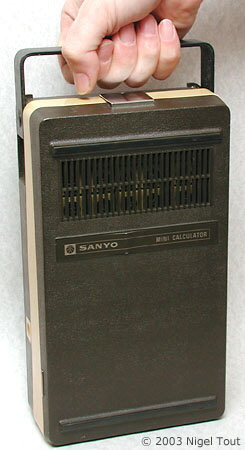
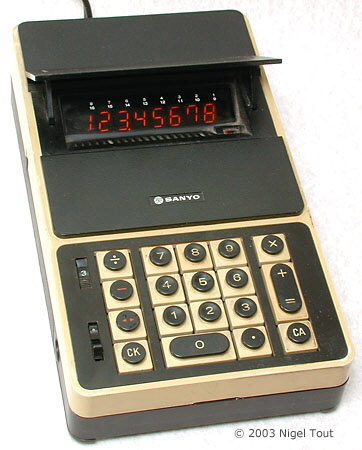
With cover on and carrying handle raised.
With cover removed, hood raised, and powered up.
Sanyo ICC-0081 "Mini Calculator"
Distinctive features: One of the first small hybrid portable electronic calculators, with built in AC supply and battery pack. Has battery-level meter.
Technical details:
Display is 8 digits amber gas-discharge tubes.
Four-function. Fixed decimal point, with settings at 0, 2, 3, 4, 6, 8.
Main integrated circuits - Sanyo LM8001J, LM8002F, LM8003G, LM8006 (date coded to end of 1971).
6v sealed rechargeable battery and built in AC adaptor/charger.
It also has a battery-level meter (just below the display on the right) and a flip-up display cover/hood.
140 x 246 x 60 mm (5.5" x 9.7" x 2.4").
Was announced in late 1969[1]. Cost in U.S.A. in June 1971 was US$425[2].
Made in Japan.
Significance: A portable electronic calculator with rechargeable batteries and built-in AC adaptor / charger. Although called a "Mini Calculator" it is really too big and heavy to be called a hand-held calculator.
The state of development of electronics at this time required four large-scale integrated circuits (LSI) for the calculating functions.
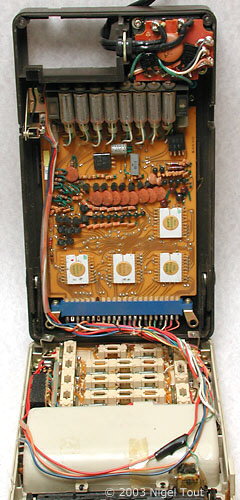
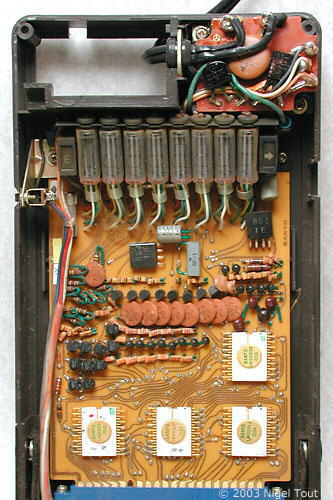
With the keyboard raised showing the circuit board and display, and the the underside of the cavity, at the bottom, that takes the rechargeable battery unit.
The circuit board with the 4 Sanyo LSI chips and the display tubes. The AC power supply / recharger is at top right, and the power cord packs into the recess at top left.
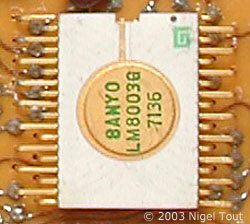
As well as having Sanyo markings, two of the white integrated circuits also have General Instruments "GI" markings on one corner - these were made by Sanyo under license from General Instruments.
This one is date-coded week 36 of 1971.
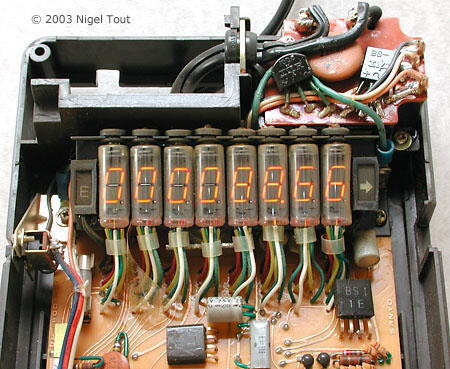
The amber gas-discharge display tubes.
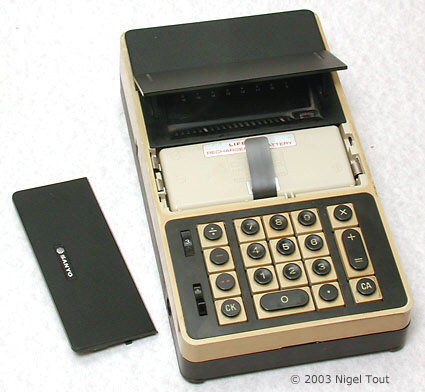
Here the cover over the rechargeable battery pack has been removed.
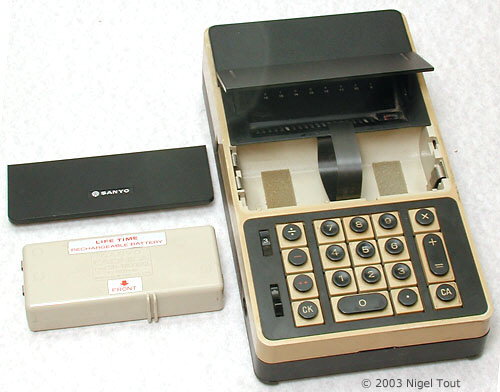
The rechargeable battery pack removed has now been removed.
The Sanyo ICC-0081 and the hand-held Sanyo ICC-82D are based on the same electronics, which was the leading edge of technology at the time. The development of the electronics was reported in the electronics technical magazines. In Sepetember 1969 the journal Electronics reported[1] "Japan's Sanyo Electric Co. is seeking government approval of a licensing arrangement reached with General Instrument Corp. Under the arrangement, Sanyo will at first import and then manufacture the U.S. firm's metal, thick-oxide nitride silicon LSI circuits for use in the Japanese company's new miniature desk calculator. The calculator is expected to go on the market early next year. Terms of the 10-year licensing arrangement call for General Instrument to receive an $80,000 initial payment and a 3.25% royalty. Although Sanyo will be allowed to sell the LSI circuits separately, the company didn't win an exclusivity clause. Sanyo is investing $4.17 million in new production facilities to manufacture the circuits. Domestic production is expected to start in June; the company's initial goal is 70,000 circuits. The calculator itself has been redesigned so that each machine will require only four or five LSI circuits."
The development problems with the ICs appear to have delayed the introduction of the Sanyo miniature hand-held calculators until about the same time that competitor calculators from Canon (Canon Pocketronic) and Sharp (Sharp QT-8B) appeared. Sanyo was then never quite at the forefront of calculator development. The miniature calculator emerged as the Sanyo IC-82D and the Sanyo 0081 "Mini Calculator", above, using integrated circuits marked with the "GI" logo of General Intruments Microelectronics of the U.S.A.
References
Portable Calculators
Vintage Calculators
Text & photographs copyright, except where stated otherwise, © Nigel Tout 2000-2026.